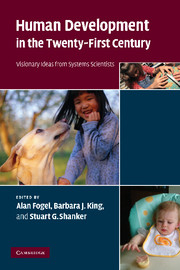Book contents
- Frontmatter
- Contents
- List of contributors
- Introduction: Why a dynamic systems approach to fostering human development?
- Part I Dynamic relationships between genetics and environments
- 1 Developmental dynamics: the new view from the life sciences
- 2 Genes, experience, and behavior
- 3 How dynamic systems have changed our minds
- 4 Individual development as a system of coactions: implications for research and policy
- 5 Gene–environment interactions and inter-individual differences in rhesus monkey behavioral and biological development
- Part II The dynamic system of the child in the family
- Part III The dynamic system of the child in social and physical environment
- Part IV Dynamic systems approaches to mental health
- Part V Conclusions and outlook
- Index
- References
5 - Gene–environment interactions and inter-individual differences in rhesus monkey behavioral and biological development
Published online by Cambridge University Press: 22 September 2009
- Frontmatter
- Contents
- List of contributors
- Introduction: Why a dynamic systems approach to fostering human development?
- Part I Dynamic relationships between genetics and environments
- 1 Developmental dynamics: the new view from the life sciences
- 2 Genes, experience, and behavior
- 3 How dynamic systems have changed our minds
- 4 Individual development as a system of coactions: implications for research and policy
- 5 Gene–environment interactions and inter-individual differences in rhesus monkey behavioral and biological development
- Part II The dynamic system of the child in the family
- Part III The dynamic system of the child in social and physical environment
- Part IV Dynamic systems approaches to mental health
- Part V Conclusions and outlook
- Index
- References
Summary
Billy seemed overly fearful and shy almost from the day he was born. As an infant he usually would avoid touching novel objects, including new toys that most others his age would eagerly grab, preferring to play instead with familiar objects. He seemed uncomfortable whenever he was brought to a new place, especially if there were strangers present. When he was a toddler he seldom sought out other youngsters as playmates, and he was often reluctant to respond when they tried to play with him. These tendencies persisted throughout his childhood, and when his male peers began leaving home to start new lives after puberty, Billy remained with his family, almost as if he were afraid to leave his familiar physical and social settings.
Fletcher, by contrast, was seemingly fearless when he was a toddler and continued to be so throughout his childhood years. However, he also appeared to be highly impulsive, even reckless, in many of his interactions with family, friends, and especially strangers. When he played with others his age he often started fights that sometimes turned out to be physically violent. Not surprisingly, he was not very popular among his peers, and by late childhood many adults from other families were already treating him as if he were a menace to their community. Once he ran away from home and was gone for six weeks.
- Type
- Chapter
- Information
- Human Development in the Twenty-First CenturyVisionary Ideas from Systems Scientists, pp. 48 - 54Publisher: Cambridge University PressPrint publication year: 2007



